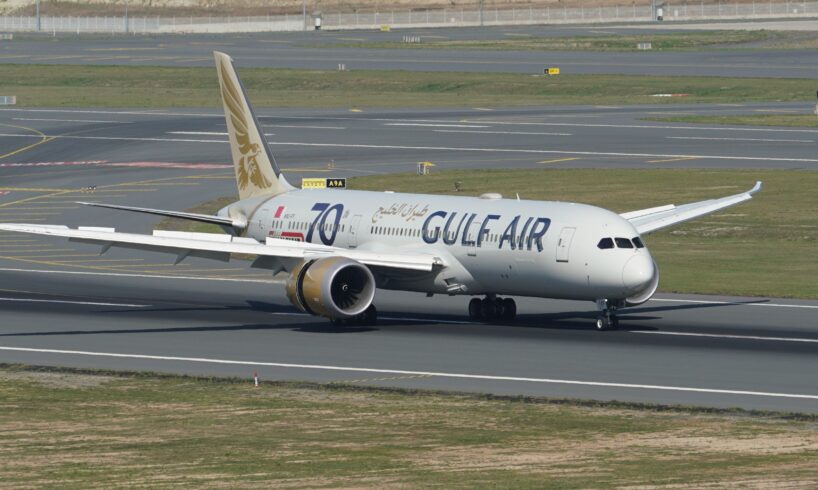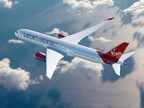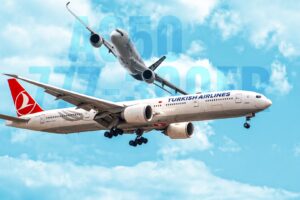
Gulf Air has confirmed that it’ll begin flying from Bahrain to New York JFK. This long-awaited route will take off on October 1, 2025, with JFK’s Terminal One to be used. The 282-seat Boeing 787-9, which is the carrier’s sole widebody type, will be deployed. Flights are now bookable.
Gulf Air flew to JFK in the 1990s. While the flights were nearly always from Bahrain, they were also from Abu Dhabi and Doha. After all, the airline was once the flag carrier of the UAE and Qatar (and also Oman). Some JFK flights were extended to Houston, a surefire way to increase costs and losses further, although fuel prices were relatively low. Gulf Air had hoped to return to the US in 2004 with ex-Air Canada A340-500s, but permission was not granted.
Gulf Air To Return To The Big Apple
Photo: GCMap
The route will cover 5,747 nautical miles (10,643 km) each way and be blocked at up to 13h 55m. It will, of course, be by far Gulf Air’s new longest service by both distance and time. It will begin soon after Etihad Airways inaugurated its longest link in five years.
Gulf Air’s US return will occur in two and a half months, which is relatively little time to grow its awareness and bookings. This will be somewhat offset by the fact that it has codeshared with American Airlines via London Heathrow to the US for years.
The long-time loss-making airline expressed interest in flying to the US in 2019, 2022, and 2024. Things appeared different last year. Group CEO Jeffrey Goh emphasized that “the airline must return to profitability,” with this new foundation paving the way for more development. Goh hinted that 2025, the year of the carrier’s 75th anniversary, would likely see its return to the US. “We must think ahead so we don’t miss the boat.” Hopefully, such expansion won’t undo its progress.
Days
Bahrain To JFK; Local Times
JFK To Bahrain; Local Times
Wednesdays, Fridays, Sundays
GF91: 04:00-10:55 (13h 55m)
GF90: 15:00-10:35+1 (12h 35m)
A High-Cost, High-Risk Experiment
Photo: OAG
With 33 daily passengers in the 12 months to May 2025, the local Bahrain-New York market is tiny. This is problematic, as long-haul routes should have a strong foundation of higher-yielding point-to-point traffic to help make them work and to offset lower-yielding, load-boosting transit traffic. Its nonstop flights will increase that volume somewhat. So will Bahrain’s desire to increase inbound tourism, like some of its neighboring countries.
Like so many Middle Eastern carriers, Gulf Air will still rely enormously on connecting traffic to/from the Indian Subcontinent, a high-volume but low-yielding market. As an example, take a look at each of Qatar Airways’ top transit markets from the US.
Although Gulf Air’s South Asian network has been trimmed recently, it still serves 14 airports in Bangladesh, India, the Maldives, Pakistan, and Sri Lanka in the second half of 2025. JFK flights would displace higher-yielding passengers from across the Middle East with lower-yielding North American travelers. Further, its 04:00 departure time from Bahrain to JFK and arrival back home (at 10:35) mean three-to-five-hour waits, which are less competitive than many carriers’ offerings.
Related
The Most Notable New Airline Routes This Week
Routes make the world go around.
Flashback: Gulf Air To The US
Photo: Konstantin von Wedelstaedt | Wikimedia
Gulf Air flew to JFK between 1994 and 1997. As it was at the end of the A340’s range, many westbound flights stopped in Larnaca. Larnaca-JFK traffic rights existed, but it was (and remains) a tiny local market, so it barely attracted any traffic. It signed an agreement with Cyprus Airways to help market JFK flights, but this did little to help performance—even though frequencies were relatively low.
While the 1990s had far less traffic than nowadays, there was less competition, so fares and yields were higher. But that’s just one part of it. The economies of the Middle Eastern nations were much smaller than they are now. There were fewer visitors and no real hubs. US-Middle East travel was all about European airlines, and many passengers connected in London with British Airways.





